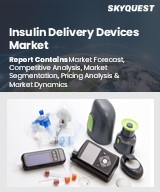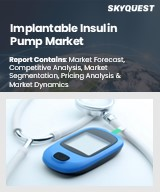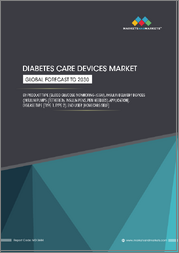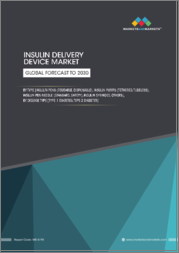
|
시장보고서
상품코드
1678515
세계의 인슐린 펌프 시장 : 규모, 점유율, 동향 분석(유형별, 제품별, 부속품별, 최종 용도별, 지역별), 부문별 예측(2025-2030년)Insulin Pump Market Size, Share & Trends Analysis Report By Type (Patch Pumps, Tethered Pumps), By Product (Mini Med, Accu-Chek), By Accessories, By End-use (Hospitals & Clinics), By Region, And Segment Forecasts, 2025 - 2030 |
||||||
인슐린 펌프 시장의 성장과 동향 :
Grand View Research, Inc.의 최신 보고서에 따르면 세계 인슐린 펌프 시장 규모는 2030년까지 96억 6,000만 달러에 이를 것으로 예측되며, 2025년부터 2030년에 걸쳐 8.42% 연평균 복합 성장률(CAGR)로 성장할 것으로 예측되고 있습니다.
시장 성장을 가속하는 주요 요인은 기술의 진보와 전통적인 방법에 대한 펌프의 채택입니다. 이 펌프는 매일 여러 번 인슐린 주사가 필요한 사람들에게 매우 유용합니다.
인슐린 펌프는 인슐린을 수동 또는 자동으로 투여할 수 있는 기계입니다. 이 펌프는 특정 복용량을 투여하도록 프로그래밍 할 수 있으며 식전과 같은 필요할 때 더 많은 양의 포도당을 투여 할 수 있습니다. 환자는 이러한 장치를 스마트폰에 연결하고 혈당 측정치를 교정할 수 있습니다. 기술 진보와 신제품 출시도 예측 기간 동안 시장을 활성화하고 있습니다. 예를 들어, Medtronic의 MiniMed 670G 시스템은 인공 췌장 역할을 하는 세계 최초의 하이브리드 폐쇄 루프 시스템입니다. 이 시스템은 환자의 CGM 측정치에 따라 자동 인슐린 투여를 수행합니다.
인슐린 펌프 시장은 정부 및 국제 당뇨병 연합(IDF)과 같은 건강 관리 조직에 의한 당뇨병 관리를 위한 지속적인 노력으로 예측 기간 동안 높은 성장률을 보일 것으로 예상됩니다. 이 단체는 필요한 전문 지식을 제공하고 이해 관계자 및 파트너 네트워크를 통해 당뇨병 계발 캠페인을 지원합니다. 또한 의료비 증가도 성장을 가속할 것으로 예상됩니다. 게다가 이 시장은 컴팩트한 사이즈와 사용 용이성을 원동력으로 기존의 끈이 달린 펌프에서 패치 펌프로의 이행이 진행될 것으로 예상됩니다.
인슐린 펌프 시장 : 분석 개요
- 테더형 펌프 분야가 2024년 시장을 독점하고 예측 기간 동안에도 시장을 선도할 것으로 예측됩니다. 테더형 인슐린 펌프는 캐뉼라에 연결된 얇은 튜브를 통해 신체에 연결됩니다.
- MiniMed 부문은 2024년에 52.9%의 점유율을 차지하고 시장을 독점했습니다.
- 인슐린 세트 삽입 장치 부문은 2024년 41.4%의 점유율로 시장을 독점했습니다. 인슐린 세트 삽입기 시장의 높은 점유율은 사용자 친화적인 디자인과 편안함의 향상으로 현저한 성장으로 인한 것입니다.
- 병원 부문은 2024년 44.4% 이상의 점유율로 시장을 독점했습니다. 병원에서는 환자의 결과를 개선하기 위해 인슐린 펌프를 포함한 고급 당뇨병 관리 기술의 도입이 진행되고 있습니다.
목차
제1장 분석 방법 및 범위
제2장 주요 요약
제3장 인슐린 펌프 시장 : 변동 요인 및 경향 및 범위
- 시장 연관 전망
- 상위 시장 전망
- 관련, 부수 시장 전망
- 시장 역학
- 시장 성장 촉진요인 분석
- 시장 성장 억제요인 분석
- 인슐린 펌프 시장 : 분석 도구
- 업계 분석 : Porter's Five Forces 분석
- PESTEL 분석
제4장 인슐린 펌프 시장 : 디바이스별 추정 및 동향 분석
- 부문 대시보드
- 세계의 인슐린 펌프 시장, 변동 분석 : 디바이스별
- 세계의 인슐린 펌프 시장 규모와 동향 분석 : 디바이스별(2018-2030년)
- 패치형 펌프
- 테더형 펌프
제5장 인슐린 펌프 시장 : 제품별 추정 및 동향 분석
- 부문 대시보드
- 세계의 인슐린 펌프 시장, 변동 분석 : 제품별
- 세계의 인슐린 펌프 시장 규모와 동향 분석 : 제품별(2018-2030년)
- MiniMed
- Accu-Chek
- Tandem
- Omnipod
- My life omnipod
- 기타
- 기타
제6장 인슐린 펌프 시장 : 부속품별 추정 및 동향 분석
- 부문 대시보드
- 세계의 인슐린 펌프 시장, 변동 분석 : 부속품별
- 세계의 인슐린 펌프 시장 규모와 동향 분석 : 부속품별(2018-2030년)
- 인슐린 저장소, 카트리지
- 인슐린 세트 삽입 장치
- 배터리
제7장 인슐린 펌프 시장 : 최종 용도별 추정 및 동향 분석
- 부문 대시보드
- 세계의 인슐린 펌프 시장, 변동 분석 : 최종 용도별
- 세계의 인슐린 펌프 시장 규모와 동향 분석 : 최종 용도별(2018-2030년)
- 병원 및 클리닉
- 재택치료
- 연구소
제8장 인슐린 펌프 시장 :지역별 추정, 동향, 분석(유형별, 제품별, 부속품별, 최종 용도별)
- 시장 점유율 분석 : 지역별(2024 및 2030년)
- 시장 대시보드 : 지역별
- 세계 시장 현황 : 지역별
- 시장 규모 예측과 동향 분석(2018-2030년)
- 북미
- 미국
- 캐나다
- 유럽
- 영국
- 독일
- 프랑스
- 이탈리아
- 스페인
- 노르웨이
- 스웨덴
- 덴마크
- 아시아태평양
- 일본
- 중국
- 인도
- 호주
- 한국
- 태국
- 라틴아메리카
- 브라질
- 아르헨티나
- 멕시코
- 중동 및 아프리카
- 남아프리카
- 사우디아라비아
- 아랍에미리트(UAE)
- 쿠웨이트
제9장 경쟁 구도
- 최근 동향과 영향 분석 : 주요 시장 진출기업별
- 기업, 경쟁의 분류
- 주요 기업의 시장 점유율 분석(2024년)
- 기업 포지션 분석
- 기업분류(신흥기업, 이노베이터, 리더)
- 기업 프로파일
- Medtronic
- Hoffmann-La Roche AG
- Tandem Diabetes Care, Inc.
- Insulet Corporation
- Ypsomed
- Sooil development
- Jiangsu Delfu Co., Ltd.
- Cellnovo Ltd
- Valeritas, Inc
Insulin Pump Market Growth & Trends:
The global insulin pump market size is estimated to reach USD 9.66 billion by 2030, registering to grow at a CAGR of 8.42% from 2025 to 2030 according to a new report by Grand View Research, Inc. The key factors driving the growth of the market are the technological advancements and the adoption of pumps over traditional methods. These pumps are very convenient for people who require daily multiple injections of insulin.
Insulin pump is a machine that enables insulin to be delivered either manually or automatically. These pumps can be programmed to deliver a specific set of doses and can also deliver a larger set of doses of glucose whenever required, such as before a meal. Patients can connect these devices to their smartphones to calibrate blood glucose readings. Technological advancement and new product launches across the globe are also fueling the market during the forecast period. For instance, Medtronic's MiniMed 670G system is the world's first hybrid closed loop system that acts as an artificial pancreas. The system provides automated insulin delivery as per the patient's CGM readings.
The insulin pumps market is anticipated to witness a high growth rate during the forecast period due to the continuous efforts for diabetes control by government and healthcare organizations such as the International Diabetes Federation (IDF). These organizations provide required expertise and support diabetes awareness campaigns through a network of stakeholders and partners. Also, increasing health care funding is anticipated to propel growth. Additionally, the market is expected to witness a shift from the usage of traditional tethered pumps to patch pumps driven by their compact size and ease of use.
Insulin Pump Market Report Highlights:
- The tethered pumps segment dominated the market in 2024 and expected to lead during the forecast period. Tethered insulin pumps are connected to the body via a small tube linked to a cannula.
- The MiniMed segment dominated the market with a share of 52.9% in 2024. the high adoption rate and technological advancement.
- The insulin set insertion devices segment dominated the market with a share of 41.4% in 2024. The insulin set insertion market high share is attributed to notable growth due to advancements in user-friendly designs and enhanced comfort.
- The hospital segment dominated the market with a share of over 44.4 % in 2024. Hospitals are increasingly adopting advanced diabetes management technologies, including insulin pumps, to improve patient outcomes.
Table of Contents
Chapter 1. Methodology and Scope
- 1.1. Market Segmentation & Scope
- 1.2. Segment Definitions
- 1.2.1. Type
- 1.2.2. Product
- 1.2.3. Accessories
- 1.2.4. End Use
- 1.2.5. Regional scope
- 1.2.6. Estimates and forecasts timeline
- 1.3. Research Methodology
- 1.4. Information Procurement
- 1.4.1. Purchased database
- 1.4.2. GVR's internal database
- 1.4.3. Secondary sources
- 1.4.4. Primary research
- 1.4.5. Details of primary research
- 1.4.5.1. Data for primary interviews in North America
- 1.4.5.2. Data for primary interviews in Europe
- 1.4.5.3. Data for primary interviews in Asia Pacific
- 1.4.5.4. Data for primary interviews in Latin America
- 1.4.5.5. Data for Primary interviews in MEA
- 1.5. Information or Data Analysis
- 1.5.1. Data analysis models
- 1.6. Market Formulation & Validation
- 1.7. Model Details
- 1.7.1. Commodity flow analysis (Model 1)
- 1.7.2. Approach 1: Commodity flow approach
- 1.7.3. Volume price analysis (Model 2)
- 1.7.4. Approach 2: Volume price analysis
- 1.8. List of Secondary Sources
- 1.9. List of Primary Sources
- 1.10. Objectives
Chapter 2. Executive Summary
- 2.1. Market Outlook
- 2.2. Segment Outlook
- 2.2.1. Type Outlook
- 2.2.2. Product Outlook
- 2.2.3. Accessories Outlook
- 2.2.4. End Use Outlook
- 2.2.5. Regional outlook
- 2.3. Competitive Insights
Chapter 3. Insulin Pumps Market Variables, Trends & Scope
- 3.1. Market Lineage Outlook
- 3.1.1. Parent market outlook
- 3.1.2. Related/ancillary market outlook
- 3.2. Market Dynamics
- 3.2.1. Market driver analysis
- 3.2.1.1. High prevalence of diabetes and associated disorders
- 3.2.1.2. Technological advancements
- 3.2.1.3. Increasing adoption of insulin pumps
- 3.2.1.4. Increase in number of product approvals
- 3.2.2. Market restraint analysis
- 3.2.2.1. High-cost barrier
- 3.2.2.2. Stringent regulatory approvals
- 3.2.1. Market driver analysis
- 3.3. Insulin Pumps Market Analysis Tools
- 3.3.1. Industry Analysis - Porter's
- 3.3.1.1. Supplier power
- 3.3.1.2. Buyer power
- 3.3.1.3. Substitution threat
- 3.3.1.4. Threat of new entrant
- 3.3.1.5. Competitive rivalry
- 3.3.2. PESTEL Analysis
- 3.3.2.1. Political landscape
- 3.3.2.2. Technological landscape
- 3.3.2.3. Economic landscape
- 3.3.1. Industry Analysis - Porter's
Chapter 4. Insulin Pumps Market: Device Estimates & Trend Analysis
- 4.1. Segment Dashboard
- 4.2. Global Insulin Pumps Device Market Movement Analysis
- 4.3. Global Insulin Pumps Market Size & Trend Analysis, by Device, 2018 to 2030 (USD Million)
- 4.4. Patch pumps
- 4.4.1. Patch pumps market estimates and forecasts 2018 to 2030 (USD Million)
- 4.5. Tethered pumps
- 4.5.1. Tethered pumps market estimates and forecasts 2018 to 2030 (USD Million)
Chapter 5. Insulin Pumps Market: Product Estimates & Trend Analysis
- 5.1. Segment Dashboard
- 5.2. Global Insulin Pumps Accessories Market Movement Analysis
- 5.3. Global Insulin Pumps Market Size & Trend Analysis, by Application, 2018 to 2030 (USD Million)
- 5.4. MiniMed
- 5.4.1. MiniMed market estimates and forecasts 2018 to 2030 (USD Million)
- 5.5. Accu-Chek
- 5.5.1. Accu-Chek market estimates and forecasts 2018 to 2030 (USD Million)
- 5.6. Tandem
- 5.6.1. Tandem market estimates and forecasts 2018 to 2030 (USD Million)
- 5.7. Omnipod
- 5.7.1. Omnipod market estimates and forecasts 2018 to 2030 (USD Million)
- 5.8. My life omnipod
- 5.8.1. My life omnipod market estimates and forecasts 2018 to 2030 (USD Million)
- 5.9. Others
- 5.9.1. Others
- 5.9.2. market estimates and forecasts 2018 to 2030 (USD Million)
Chapter 6. Insulin Pumps Market: Accessories Estimates & Trend Analysis
- 6.1. Segment Dashboard
- 6.2. Global Insulin Pumps Accessories Market Movement Analysis
- 6.3. Global Insulin Pumps Market Size & Trend Analysis, by Accessories, 2018 to 2030 (USD Million)
- 6.4. Insulin reservoir or cartridges
- 6.4.1. Insulin reservoir or cartridges market estimates and forecasts 2018 to 2030 (USD Million)
- 6.5. Insulin set insertion devices
- 6.5.1. Insulin set insertion devices market estimates and forecasts 2018 to 2030 (USD Million)
- 6.6. Battery
- 6.6.1. Battery market estimates and forecasts 2018 to 2030 (USD Million)
Chapter 7. Insulin Pumps Market: End Use Estimates & Trend Analysis
- 7.1. Segment Dashboard
- 7.2. Global Insulin Pumps End Use Market Movement Analysis
- 7.3. Global Insulin Pumps Market Size & Trend Analysis, by End Use, 2018 to 2030 (USD Million)
- 7.4. Hospitals & Clinics
- 7.4.1. Hospitals & Clinics market estimates and forecasts 2018 to 2030 (USD Million)
- 7.5. Homecare
- 7.5.1. Homecare market estimates and forecasts 2018 to 2030 (USD Million)
- 7.6. Laboratories
- 7.6.1. Laboratories market estimates and forecasts 2018 to 2030 (USD Million)
Chapter 8. Insulin Pumps Market: Regional Estimates & Trend Analysis By Type, Product, Accessories, End Use
- 8.1. Regional Market Share Analysis, 2024 & 2030
- 8.2. Regional Market Dashboard
- 8.3. Global Regional Market Snapshot
- 8.4. Market Size, & Forecasts Trend Analysis, 2018 to 2030:
- 8.5. North America
- 8.5.1. U.S.
- 8.5.1.1. Key country dynamics
- 8.5.1.2. Competitive scenario
- 8.5.1.3. Regulatory framework
- 8.5.1.4. Reimbursement structure
- 8.5.1.5. U.S. market estimates and forecasts 2018 to 2030 (USD Million)
- 8.5.2. Canada
- 8.5.2.1. Key country dynamics
- 8.5.2.2. Competitive scenario
- 8.5.2.3. Regulatory framework
- 8.5.2.4. Reimbursement structure
- 8.5.2.5. Canada market estimates and forecasts 2018 to 2030 (USD Million)
- 8.5.1. U.S.
- 8.6. Europe
- 8.6.1. UK
- 8.6.1.1. Key country dynamics
- 8.6.1.2. Competitive scenario
- 8.6.1.3. Regulatory framework
- 8.6.1.4. Reimbursement structure
- 8.6.1.5. UK market estimates and forecasts 2018 to 2030 (USD Million)
- 8.6.2. Germany
- 8.6.2.1. Key country dynamics
- 8.6.2.2. Competitive scenario
- 8.6.2.3. Regulatory framework
- 8.6.2.4. Reimbursement structure
- 8.6.2.5. Germany market estimates and forecasts 2018 to 2030 (USD Million)
- 8.6.3. France
- 8.6.3.1. Key country dynamics
- 8.6.3.2. Competitive scenario
- 8.6.3.3. Regulatory framework
- 8.6.3.4. Reimbursement structure
- 8.6.3.5. France market estimates and forecasts 2018 to 2030 (USD Million)
- 8.6.4. Italy
- 8.6.4.1. Key country dynamics
- 8.6.4.2. Competitive scenario
- 8.6.4.3. Regulatory framework
- 8.6.4.4. Reimbursement structure
- 8.6.4.5. Italy market estimates and forecasts 2018 to 2030 (USD Million)
- 8.6.5. Spain
- 8.6.5.1. Key country dynamics
- 8.6.5.2. Competitive scenario
- 8.6.5.3. Regulatory framework
- 8.6.5.4. Reimbursement structure
- 8.6.5.5. Spain market estimates and forecasts 2018 to 2030 (USD Million)
- 8.6.6. Norway
- 8.6.6.1. Key country dynamics
- 8.6.6.2. Competitive scenario
- 8.6.6.3. Regulatory framework
- 8.6.6.4. Reimbursement structure
- 8.6.6.5. Norway market estimates and forecasts 2018 to 2030 (USD Million)
- 8.6.7. Sweden
- 8.6.7.1. Key country dynamics
- 8.6.7.2. Competitive scenario
- 8.6.7.3. Regulatory framework
- 8.6.7.4. Reimbursement structure
- 8.6.7.5. Sweden market estimates and forecasts 2018 to 2030 (USD Million)
- 8.6.8. Denmark
- 8.6.8.1. Key country dynamics
- 8.6.8.2. Competitive scenario
- 8.6.8.3. Regulatory framework
- 8.6.8.4. Reimbursement structure
- 8.6.8.5. Denmark market estimates and forecasts 2018 to 2030 (USD Million)
- 8.6.1. UK
- 8.7. Asia Pacific
- 8.7.1. Japan
- 8.7.1.1. Key country dynamics
- 8.7.1.2. Competitive scenario
- 8.7.1.3. Regulatory framework
- 8.7.1.4. Reimbursement structure
- 8.7.1.5. Japan market estimates and forecasts 2018 to 2030 (USD Million)
- 8.7.2. China
- 8.7.2.1. Key country dynamics
- 8.7.2.2. Competitive scenario
- 8.7.2.3. Regulatory framework
- 8.7.2.4. Reimbursement structure
- 8.7.2.5. China market estimates and forecasts 2018 to 2030 (USD Million)
- 8.7.3. India
- 8.7.3.1. Key country dynamics
- 8.7.3.2. Competitive scenario
- 8.7.3.3. Regulatory framework
- 8.7.3.4. Reimbursement structure
- 8.7.3.5. India market estimates and forecasts 2018 to 2030 (USD Million)
- 8.7.4. Australia
- 8.7.4.1. Key country dynamics
- 8.7.4.2. Competitive scenario
- 8.7.4.3. Regulatory framework
- 8.7.4.4. Reimbursement structure
- 8.7.4.5. Australia market estimates and forecasts 2018 to 2030 (USD Million)
- 8.7.5. South Korea
- 8.7.5.1. Key country dynamics
- 8.7.5.2. Competitive scenario
- 8.7.5.3. Regulatory framework
- 8.7.5.4. Reimbursement structure
- 8.7.5.5. South Korea market estimates and forecasts 2018 to 2030 (USD Million)
- 8.7.6. Thailand
- 8.7.6.1. Key country dynamics
- 8.7.6.2. Competitive scenario
- 8.7.6.3. Regulatory framework
- 8.7.6.4. Reimbursement structure
- 8.7.6.5. Thailand market estimates and forecasts 2018 to 2030 (USD Million)
- 8.7.1. Japan
- 8.8. Latin America
- 8.8.1. Brazil
- 8.8.1.1. Key country dynamics
- 8.8.1.2. Competitive scenario
- 8.8.1.3. Regulatory framework
- 8.8.1.4. Reimbursement structure
- 8.8.1.5. Brazil market estimates and forecasts 2018 to 2030 (USD Million)
- 8.8.2. Argentina
- 8.8.2.1. Key country dynamics
- 8.8.2.2. Competitive scenario
- 8.8.2.3. Regulatory framework
- 8.8.2.4. Reimbursement structure
- 8.8.2.5. Argentina market estimates and forecasts 2018 to 2030 (USD Million)
- 8.8.3. Mexico
- 8.8.3.1. Key country dynamics
- 8.8.3.2. Competitive scenario
- 8.8.3.3. Regulatory framework
- 8.8.3.4. Reimbursement structure
- 8.8.3.5. Canada market estimates and forecasts 2018 to 2030 (USD Million)
- 8.8.1. Brazil
- 8.9. MEA
- 8.9.1. South Africa
- 8.9.1.1. Key country dynamics
- 8.9.1.2. Competitive scenario
- 8.9.1.3. Regulatory framework
- 8.9.1.4. Reimbursement structure
- 8.9.1.5. South Africa market estimates and forecasts 2018 to 2030 (USD Million)
- 8.9.2. Saudi Arabia
- 8.9.2.1. Key country dynamics
- 8.9.2.2. Competitive scenario
- 8.9.2.3. Regulatory framework
- 8.9.2.4. Reimbursement structure
- 8.9.2.5. Saudi Arabia market estimates and forecasts 2018 to 2030 (USD Million)
- 8.9.3. UAE
- 8.9.3.1. Key country dynamics
- 8.9.3.2. Competitive scenario
- 8.9.3.3. Regulatory framework
- 8.9.3.4. Reimbursement structure
- 8.9.3.5. UAE market estimates and forecasts 2018 to 2030 (USD Million)
- 8.9.4. Kuwait
- 8.9.4.1. Key country dynamics
- 8.9.4.2. Competitive scenario
- 8.9.4.3. Regulatory framework
- 8.9.4.4. Reimbursement structure
- 8.9.4.5. Kuwait market estimates and forecasts 2018 to 2030 (USD Million)
- 8.9.1. South Africa
Chapter 9. Competitive Landscape
- 9.1. Recent Developments & Impact Analysis, By Key Market Participants
- 9.2. Company/Competition Categorization
- 9.3. Key company market share analysis, 2024
- 9.4. Company Position Analysis
- 9.5. Company Categorization (Emerging Players, Innovators and Leaders
- 9.6. Company Profiles
- 9.6.1. Medtronic
- 9.6.1.1. Company overview
- 9.6.1.2. Financial performance
- 9.6.1.3. Device benchmarking
- 9.6.1.4. Strategic initiatives
- 9.6.2. Hoffmann-La Roche AG
- 9.6.2.1. Company overview
- 9.6.2.2. Financial performance
- 9.6.2.3. Device benchmarking
- 9.6.2.4. Strategic initiatives
- 9.6.3. Tandem Diabetes Care, Inc.
- 9.6.3.1. Company overview
- 9.6.3.2. Financial performance
- 9.6.3.3. Device benchmarking
- 9.6.3.4. Strategic initiatives
- 9.6.4. Insulet Corporation
- 9.6.4.1. Company overview
- 9.6.4.2. Financial performance
- 9.6.4.3. Device benchmarking
- 9.6.4.4. Strategic initiatives
- 9.6.5. Ypsomed
- 9.6.5.1. Company overview
- 9.6.5.2. Financial performance
- 9.6.5.3. Device benchmarking
- 9.6.5.4. Strategic initiatives
- 9.6.6. Sooil development
- 9.6.6.1. Company overview
- 9.6.6.2. Financial performance
- 9.6.6.3. Device benchmarking
- 9.6.6.4. Strategic initiatives
- 9.6.7. Jiangsu Delfu Co., Ltd.
- 9.6.7.1. Company overview
- 9.6.7.2. Financial performance
- 9.6.7.3. Device benchmarking
- 9.6.7.4. Strategic initiatives
- 9.6.8. Cellnovo Ltd
- 9.6.8.1. Company overview
- 9.6.8.2. Financial performance
- 9.6.8.3. Device benchmarking
- 9.6.8.4. Strategic initiatives
- 9.6.9. Valeritas, Inc
- 9.6.9.1. Company overview
- 9.6.9.2. Financial performance
- 9.6.9.3. Device benchmarking
- 9.6.9.4. Strategic initiatives
- 9.6.1. Medtronic
(주말 및 공휴일 제외)


















